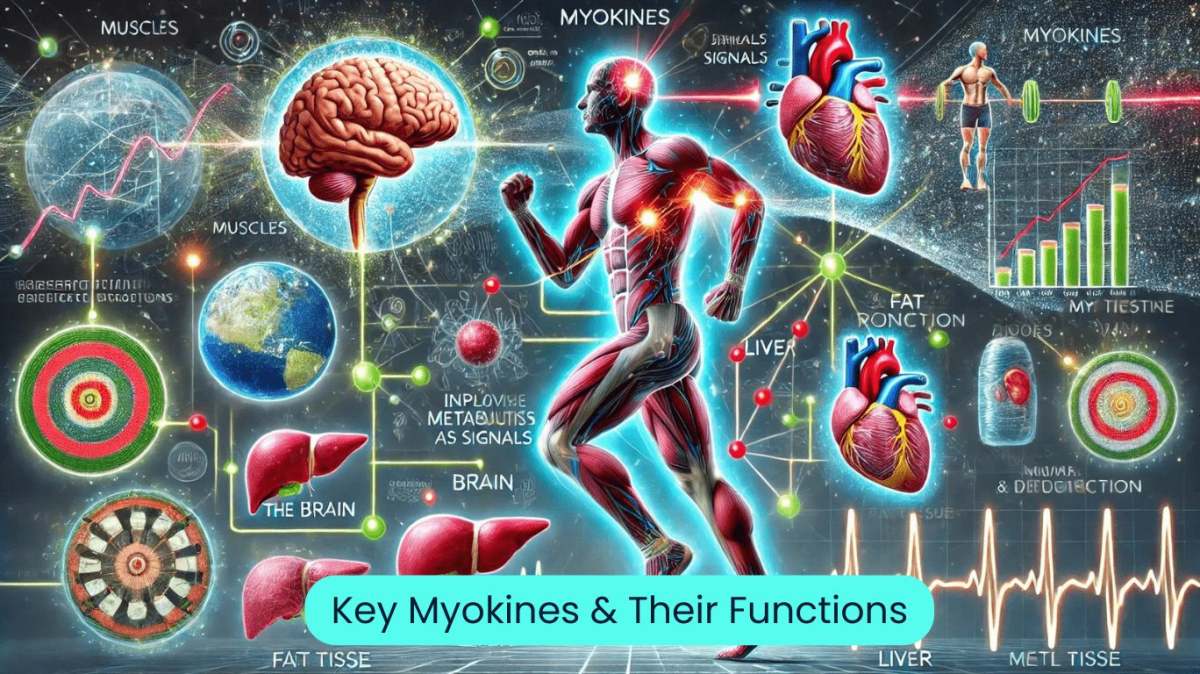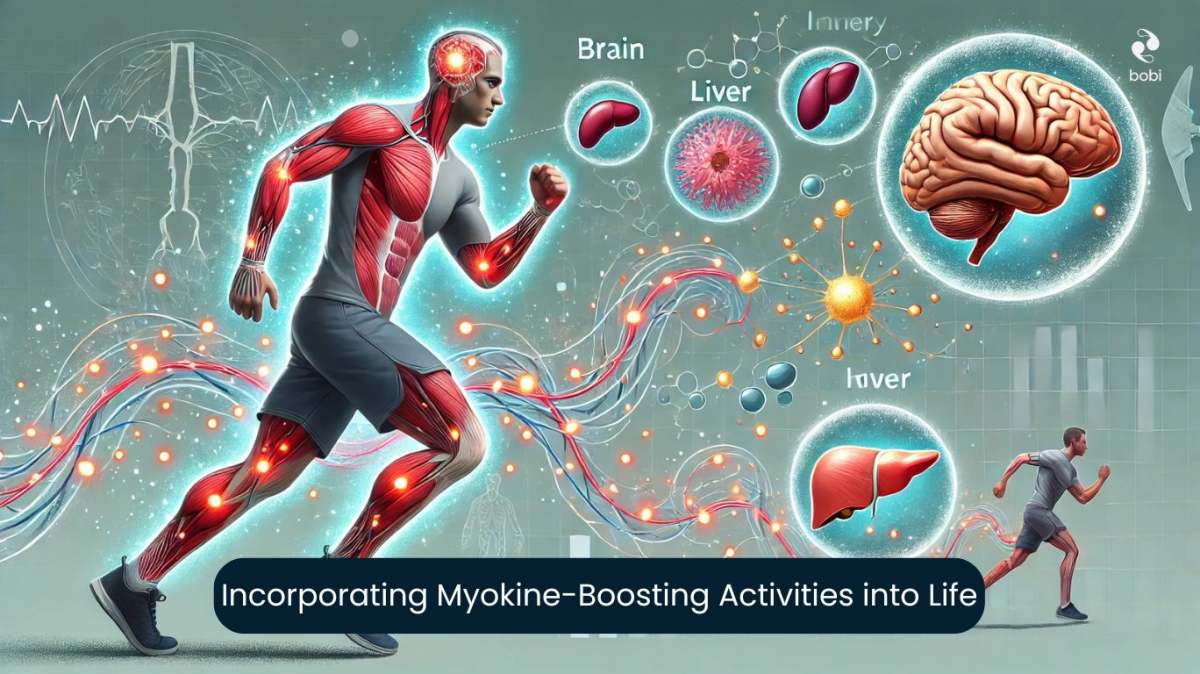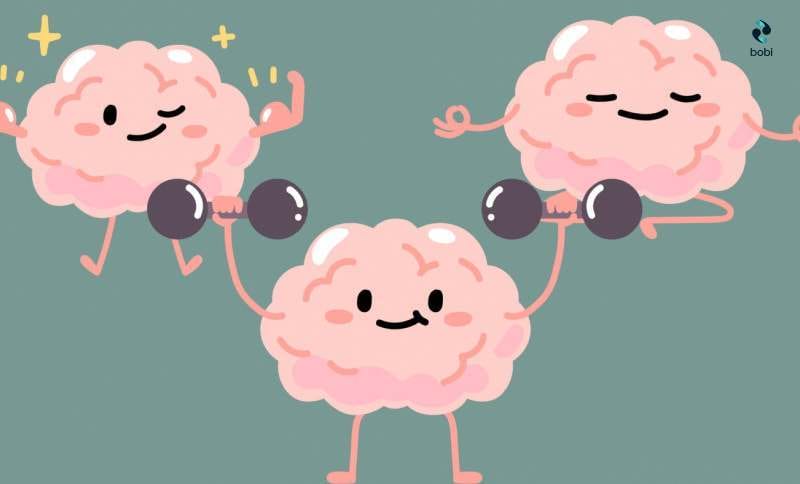
Mostly tagged as the “secret weapon” of muscles, myokines are protein messengers made and secreted by muscle fibers. They function as hormone signals, playing a critical role in connecting with different body organs, along with the liver, fat tissue, and brain. For a long time, we knew that physical movement reduces the possibility of a network of diseases because it works perfectly as a medicine for culture-related illnesses like dementia, type 2 diabetes, heart issues, and cancer.
However, we needed to fully understand why. Now scientists have discovered the missing piece of the puzzle: “myokines”. Our muscles make and release these signaling molecules, especially when we exercise. In this detailed guide, we’ll explore myokines in-depth, key myokines and their functions, their impact on metabolic functions, and mental health, their role in disease prevention, practical advice to boost their production, and much more.
Imagine this: you are in the middle of a tough workout, and your muscles are working hard. What you don’t know is that they are talking to the rest of your body. This chat happens through special signals called myokines, which send messages that affect how your body works.
The word “myokine” comes from two Greek words: “mys,” which means muscle, and “kinos,” which means movement. This shows that these are messengers made by muscles. In 2003 the definition and utilization of the word myokine first happened.
The very first myokine, myostatin, was discovered in 2008. Researchers have found many myokines, but the first and most famous myokine identified to be released in the blood circulation in reaction to muscle contractions was interleukin-6 (IL-6). At first, IL-6 was thought to be an inflammatory molecule. However, when it comes from skeletal muscle cells, it shows anti-inflammatory and metabolic benefits.
This was a key finding because it showed that myokines can have different roles based on where they come from and where they go. Later research has broadened the knowledge about these proteins beyond just IL-6. Scientists have discovered many different myokines, each with its special properties and functions.
Long ago, we used to consider muscles as tools that allow us to pick up objects, stand upright, munch, and so on. However, eventually, they’re much more complicated. Scientists have now declared that muscles are endocrine organs as they secret hormones.
Myokines come from muscles too and are very important for keeping muscles healthy. They help in processes like muscle repair, growth, and adapting to exercise. Think of these molecules as hard workers on a busy construction site. They regularly fix, rebuild, and strengthen muscle tissue.
Myokines help control muscle mass by affecting how proteins are made and broken down. Some of these molecules encourage muscle hypertrophy, which means they make muscles bigger and stronger.
Others help protect against muscle atrophy. This means they keep muscle tissue safe during times when a person is not moving much or is sick.
The way myokines work together helps our muscles deal with any stress from tough workouts or even something as simple as walking. Knowing what they can do for muscle health may help us find new ways to treat muscle-wasting diseases and improve how our muscles work overall.
Myokines work by connecting with certain receptors on cells in the body. You can imagine these receptors as special spots that receive signals from specific myokines.
When they attach to their right receptors, they trigger a series of signals inside the cells. This affects how genes function and how the cells act in the target area. Because of this process, myokines can control many body functions, not just those related to muscles.
Exercise is the main trigger for the production and release of myokines. Skeletal muscles, which are responsible for almost 40% of whole body weight are considered endocrine organs. Each time muscles contract, many events happen at a molecular level.
These muscular contractions of skeletal muscles release cytokines known as myokines into blood flow. The harder you exercise, the stronger the myokine response will be.
One important reason for myokine release is the higher energy demand from muscles during activity. When muscles work harder, their energy use changes. This focuses on signaling in the cells, which boosts myokine production.
Also, things like stress on the muscles, low oxygen levels, and tiny injuries in the muscle fibers during exercise can all lead to higher myokine levels. This shows how muscle tissue interacts with the rest of the body and its ability to communicate well.
As more than 650 myokines are discovered, their role has been previously evaluated. They play a crucial role in muscle regeneration, multiplication, and differentiation. When we exercise and push our muscles, we create small injuries in the muscle fibers.
This may seem strange, but these small tears are important for muscle growth and adaptation. Myokines act as the main leaders in muscle repair, helping to coordinate the repair of damaged tissue.
They help by activating satellite cells, which are the stem cells for muscle tissue. These cells then grow and change into new muscle cells. These new cells combine with existing fibers, aiding muscle repair and growth. Myokines also help with protein synthesis, which is necessary for muscle regeneration.
Myokines do more than just help muscles; they also affect many metabolic processes in the body. They can change how our bodies use glucose, manage fat storage, and even affect how hungry we feel. This shows that myokines play an important role in keeping our metabolism balanced.
The influence of myokines goes beyond just muscle. They also affect our fat stores. Studies show that some myokines can help us lose fat by increasing how much energy we burn, improving insulin sensitivity, and even changing white fat into a healthier form.
Adipose tissue, or fat, was once thought of only as a storage place for energy. Now, it is seen as an active endocrine organ. Myokines help the communication between muscle and fat tissue, which affects how fat cells work.
For instance, myokine Irisin can turn white fat, which stores energy, into brown fat, which burns calories and creates heat, so contributing to fat loss. The results are multiplied during routine exercise, ensuring myokine is a necessary factor in weight management and metabolic health.
Maintaining steady blood sugar levels is vital for good health. Myokines have an important role in keeping glucose levels balanced. They do this mainly by improving insulin sensitivity. This means cells can absorb glucose from the blood better.
Insulin resistance is a key issue in type 2 diabetes. It can disrupt how glucose is processed, causing higher blood sugar levels. Myokines act as insulin sensitizers. They help the body respond better to insulin. This helps move glucose from the blood into cells.
Some myokines can even stimulate glucose uptake without needing insulin. This adds another way to manage blood sugar levels. Involving in regular exercise, which increases myokine production, can notably enhance blood glucose regulation and overall metabolic well-being.
Myokines are more than just important for metabolism. They play a big role in our immune system. They can help boost the immune response and also keep it balanced. This balance is crucial for our overall health.
Think of myokines as conductors in an immune orchestra. They help manage different immune cells to fight off infections and protect against chronic diseases.
Regular exercise is well-known for helping the immune system, and myokines help explain how this works. They serve as signaling molecules that improve immune activity and foster anti-inflammatory reactions.
When you work out, muscles release myokines that help immune cells work better, boosting your body’s defense.
These myokines improve the immune system’s ability to find and fight off germs. This helps lower the chances of getting sick. Exercise-induced myokines also reduce inflammation and activate the functioning of immune cells such as T-cells and natural killer cells.
This is to target long-term issues that can lead to chronic diseases like heart disease, type 2 diabetes, and even some cancers. This is why consistent exercise is mostly connected to enhanced immunity and lowered probability of chronic diseases.
Inflammation is a double-edged sword _ it helps our body heal and fight infections. But when inflammation becomes chronic and low-grade, it can cause health problems. Myokines help regulate inflammation like firefighters. They calm excessive inflammation before it can harm the body.
Some myokines, like IL-6, can help or hurt inflammation depending on the situation. Other myokines mainly help by reducing pro-inflammatory cytokines. These cytokines are signals that can increase inflammation. By reducing these signals, myokines keep inflammation in check.
Myokines play an important role in balancing the immune system. By reducing chronic inflammation, they help protect against many diseases linked to inflammation.

The world of myokines is big and varied, with new molecules being found all the time. Each of these messengers has its own special characteristics and functions. They play important parts in how our bodies talk to each other.
Let’s take a look at some of the important players in this complex system.
Irisin, specified as the “exercise hormone” is secreted during physical movement.
Myostatin is different from many myokines that help with muscle growth.
Interleukin-6 (IL-6) is IL-6 and has extremely investigated myokine among all.
BDNF, which stands for brain-derived neurotrophic factor _ is the second element of the neutrophin tree of growth factors and is very important for how our brains work.
Decorin is another myokine that is released in skeletal muscles during exercise.
Myokines can do more than just help you stay fit. They are now seen as strong helpers in stopping and managing diseases. Myokines affect many systems in the body, which makes them great options for creating new treatments for ongoing health issues.
Think of them like small soldiers in the body. They work hard to protect you from getting sick and slowing down diseases.
Obesity is the most prevailing issue around the world and causes various metabolic problems. Researchers are looking at these molecules as possible tools to help fight this complicated disease.
Some myokines can act on fat tissue. They can help break down stored fat and improve how the body uses fatty acids for energy.
This change can lead to weight loss and better body makeup, losing fat while keeping muscle tissue intact. They also have a role in controlling appetite. They can make you feel full and help lower the amount of food you eat, which can aid in managing weight.
Myokines are special molecules that can help manage and possibly prevent diabetes. They help control blood sugar by working together with insulin.
These special molecules improve insulin’s effects. They help move glucose from the blood into our cells, which lowers sugar levels. Some myokines can even help take up glucose without needing insulin. This gives us another way to manage blood sugar levels.
Cardiovascular disease is still a major cause of death around the world. Myokines are important because they can impact blood vessels, help control blood pressure, and reduce inflammation, which can help protect heart health.
Some myokines help create new blood vessels. This is called angiogenesis. It helps improve blood flow and gets more oxygen to tissues. Others can lower inflammation in blood vessels. This is very important because inflammation can lead to atherosclerosis, which can cause heart attacks and strokes.
On top of that, myokines can make the heart pump better. This helps guard against heart failure.
While research on myokines in cancer therapy is still new, it has excited many scientists. Some studies have shown that they can stop tumor growth in both direct and indirect ways. This could be a new way to fight this tough disease.
Some myokines can directly limit cancer cell growth, which helps slow down tumors. They can also change the tumor microenvironment, which is the area around the tumor that helps it grow. This makes it less friendly for cancer cells.
More research is needed to understand how myokines work and how they can be used in treatment. However, these molecules show potential for creating new cancer therapies, either alone or with current treatments.
Aging often leads to a loss of muscle mass, strength, and function. This loss is called sarcopenia. Myokines can help fight age-related muscle loss. They support muscle growth and healing, which is important for older adults.
Maintaining muscle mass and function is very important for aging healthily. Myokines can help with this. They play a big role in muscle growth, healing, and repair. This makes them a good option for fighting muscle decline as we get older and promoting movement in older adults.
As we age, we naturally lose skeletal muscle mass and strength. This can lead to less mobility and more chances of falling. Myokines act like messengers in our muscles. They help slow down this decline by promoting muscle protein synthesis, supporting the growth of new muscle fibers, and helping muscles heal after injuries.
By keeping muscle mass and function, myokines can help older adults stay independent and mobile. This can improve their overall quality of life.
Chronic inflammation, also called “inflammaging,” is a common part of aging. It leads to many diseases linked to getting older, such as cardiovascular disease, Alzheimer’s, and arthritis. Myokines have anti-inflammatory benefits. They can be a helpful way to fight inflammation that comes with age.
As we grow older, our immune system changes. This often results in low-grade chronic inflammation. This ongoing inflammation can harm tissues and organs. It speeds up aging and increases the risk of chronic diseases. Myokines come from our muscles and can help lessen this chronic inflammation, making its effects less harmful.

Exercise does more than build muscle and burn calories. It also boosts the production of myokines, which are important signaling molecules. Each time you exercise, your body releases more of these amazing proteins, providing many health benefits.
By learning how different types, strengths, and lengths of exercise affect myokine levels, we can create custom workout plans. So, let’s dive into it.
While all exercise is good for you, different types of workouts create different myokine levels. Both aerobic and resistance exercises make changes in myokine levels, without any notable distinction between practicing modes.
Aerobic exercises like running, swimming, or cycling mainly boost myokines which help with energy metabolism and are exceptional for increasing irisin and IL-6 levels. This can lead to better fat-burning and improved insulin sensitivity.
Resistance exercise includes weight lifting or using resistance bands. This type of workout helps release myokines that support muscle growth and repair. As a result, you can gain more muscle mass and strength.
Mixing endurance and resistance training gives a complete approach and gets the most out of various myokines. These exercises improve cardiovascular health, enhance metabolism, and help with fast loss.
The level of physical activity is very important for how much and what type of myokine the body releases. Usually, the more you push your body, the more myokines you make. Hard exercise leads to a bigger increase in myokine levels, which allows you to gain greater benefits.
Average to High-intensity aerobic exercises like high-intensity interval training (HIIT), are popular right now. This exercise includes short, hard bursts of activity with quick breaks. HIIT can notably boost the release of myokines such as irisin, IL-6, and BDNF.
It is effective in boosting myokines because it quickly changes energy needs. This change causes a strong myokine response and helps the body adjust and improve its functions.
Resistance exercises, involving bodyweight or weightlifting exercises also activate the secretion of myokines but tend to create a different profile.
But remember even moderate exercise, like walking at a quick pace, can really affect myokine levels too. The most important thing is to find an exercise you enjoy that is also challenging. This helps you stick to it long-term and improves your physical activity benefits.
Resistance training like circuit training or weightlifting is great for building muscle and strength. This type of exercise includes lifting weights or using resistance bands. It leads to a special release of myokines that help muscles grow bigger, which we call muscle hypertrophy.
During resistance training, myokines are released that help in muscle protein synthesis. This is the process where new muscle proteins are made. These molecules also support satellite cell activity, which helps create new muscle fibers and adds to overall muscle growth.
Besides building muscle, resistance training also helps with insulin sensitivity, bone strength, and general metabolic health.
The discovery of myokines has opened a new and exciting area in biomedical research. Scientists are learning how these important molecules work. This means that we could develop specific treatments for many diseases. Imagine a future where therapies using myokines can help with obesity, diabetes, brain health, and even cancer.
The study of myokines is still new. Scientists keep finding new myokines all the time. Each one has the power to show us new ways cells talk to each other and how they affect our bodies.
Researchers are using advanced tools, like high-throughput screening and gene expression profiling, to find and learn about these new myokines. These methods help us understand how muscles work with other parts of the body.
The future of myokine research is very exciting for personalized medicine. Picture a world where doctors can look at a person’s myokine profile. This profile would match their genes and lifestyle. They could then create special plans to help improve health.
By knowing a person’s unique myokine signals, doctors could make personalized workout plans, diet tips, and treatment options just for them. This way could change healthcare by improving how we prevent and treat diseases.
You don’t have to be a marathon runner or a bodybuilder to enjoy the benefits of myokines. Making small, sustainable changes in your daily life and engaging in some exercises can boost myokine production and improve your health.
You don’t need a gym membership or fancy tools to help your body produce myokines. Simple and fun exercises can easily fit into your daily life and really help.
Following are a few easy exercises that you can do to improve myokine advantages:
Beyond just physical exercise, changing some lifestyle habits can help produce more myokines and improve their health benefits. Choosing to support your body’s myokine production can greatly affect your overall well-being.

Exercise is good for more than just physical health. It also helps mental well-being. New studies show a strong link between myokines and mental health. Myokines are special molecules that can help fight mood disorders.
Some of these molecules can cross into the brain. They can affect how the brain works, along with brain chemicals and its ability to change.
The saying “a healthy body leads to a healthy mind” is very true when we think about how exercise helps our minds. This is because the relationship between mental health and exercise is deep, and myokines play a notable role in this connection.
Exercise is like a reset button for your brain. It boosts myokines that are neuroprotective and support a range of mental health benefits, says Dr. John Ratey, a psychiatrist and author of Spark: The Revolutionary New Science of Exercise and the Brain.
Chronic stress can harm our physical and mental health. However, myokines are showing promise in linking exercise, stress relief, and emotional health.
Although physical exercise particularly aerobic exercise has been found to lower stress hormones such as cortisol while at the same time increasing “feel-good” neurotransmitters such as dopamine and serotonin.
This harmony is somewhat arranged by myokines such as irisin and IL-6, which control mood and possess anti-inflammatory characteristics that alleviate the dangerous effects of serious stress.
Additionally, myokines can make us mentally stronger. They improve our ability to handle stress and recover from tough times.
Myokines are a new area of science. This means there are many misunderstandings about them. It is important to tell apart facts from false information and use reliable scientific sources.
In today’s world, we see a lot of information everywhere. This makes it easy to find false information. When looking at myokine research, it’s important to know the difference between real science and personal stories.
Always check where you got the information. You should trust sources that offer proof based on facts. When looking for studies, focus on those from respected peer-reviewed journals.
Several myths about exercise and myokine release can be confused.
While many people think myokines relate mostly to physical activity, new studies show they are also linked to sleep. The relationship between exercise, myokines, and sleep is very important for our health and well-being.
Sleep quality is very important for controlling myokine levels. Research shows that not getting enough sleep or having poor-quality sleep can affect how myokines are released from skeletal muscle cells.
When we do not get enough sleep, it can change how myokines are made, which impacts their functions in our body. Good sleep is needed to keep myokine levels at their best. These levels help control energy metabolism, reduce inflammation, and improve overall health.
Myokines are substances released by our skeletal muscles when we exercise. They are important for controlling many functions in our body. One interesting thing is how myokines can affect our sleep. These molecules can change the sleep-wake cycle and help improve sleep quality.
They influence the brain’s release of certain chemicals that help regulate our internal clock and can make sleep deeper and longer. By doing regular physical activity that boosts myokine levels, we may improve our sleep habits and feel better overall.
Myokines are very important in professional sports. They help boost performance and speed up recovery. These are special proteins made by muscles during exercise. They affect how our body works in many ways.
Using the advantages of myokines can significantly change the game in professional sports. This offers athletes a natural way to improve their performance and recovery methods.
Athletic training programs are now using myokines more often to help improve performance and recovery. They are important for helping muscles work better and improving overall fitness.
By using the endocrine effects of myokines, athletes can boost muscle growth, strength, and endurance. This leads to better performance during workouts and quicker recovery after training. Adding myokines to training programs gives a complete way to improve athletic skills and reach peak physical condition.
Myokines are important for preventing injuries and helping recovery. They do more than just support muscles. They help repair tissue, reduce swelling, and improve healing after an injury.
By encouraging muscle growth and repair, myokines make the injured area stronger and lower the chance of getting hurt again. Their ability to reduce inflammation helps people heal faster, letting them get back to their daily activities sooner. Doing certain exercises that trigger myokine release can help prevent injuries and speed up recovery.

Myokines connect with other hormones in a network that affects many body functions. For example, they work with growth hormones to help muscles grow and repair. They also influence insulin and play a role in insulin sensitivity and glucose homeostasis, which is how the body manages sugar levels.
Learning how these molecules connect with different hormones helps us understand the impact of exercise on our hormone health and metabolism.
Myokines and growth hormones work well together. They help control important processes in our body. The way they interact is essential for muscle growth, repair, and better metabolism.
By boosting each other’s effects, myokines and growth hormones help keep skeletal muscle mass and improve metabolic health. This teamwork shows how important it is to have a balanced relationship between different signals in the body. It highlights the complex connections that manage how our body works.
Myokines are important because they interact with insulin. This interaction helps manage blood sugar levels and improves insulin sensitivity. When we exercise, our skeletal muscle releases these signaling molecules.
Studies show that myokines can boost how insulin works, which is key for keeping our glucose homeostasis in check. The link between myokines and insulin affects metabolic processes and can help reduce insulin resistance. Learning more about this relationship could lead to new treatments for diabetes and metabolic syndrome.
Myokine recognition has radically changed how we see the function of muscles in the body. A long way from being just instruments for movement, muscles talk virtually with every organ system via the secretion of these strong signaling proteins. They act as a bridge between exercise and whole-body health, influencing metabolism, immune response, fat loss, muscle regeneration, and even mental health. Learning more about myokines could lead to new research and uses in areas like sports performance, preventing injuries, and treating metabolic disorders. As we study myokines more, we can see how they might change our understanding of exercise and health outcomes.
Finding the important myokine needed for health is crucial. It plays a big role in energy metabolism, brain function, sleep quality, and sports performance. Knowing this helps us see how it can improve our overall well-being.
Myokines begin to react to exercise right away. Some studies show that myokine levels can even rise during the workout. This quick response shows how active they are and suggests they may help improve exercise performance and recovery.
Myokine levels can change due to more than just exercise. Good sleep, proper nutrition, and managing stress are important for boosting myokines. Although exercise is a major driver, our overall lifestyle choices can also affect myokine production.
Myokines usually help improve health. They support metabolism, brain function, and sleep. However, too many myokines might cause inflammation or problems with metabolism. Keeping an eye on myokine levels and talking to a doctor can help reduce any possible bad effects.
Age plays a big role in how the body makes and uses myokines. As people get older, myokine levels can decrease. This change can affect things like metabolism and how well the brain works. Knowing more about how age changes myokine levels is important. It helps us use the benefits of myokines better as we go through different stages of life.
Stay updated on what's happening at bobi, and all things breathing, anxiety and mental wellness.